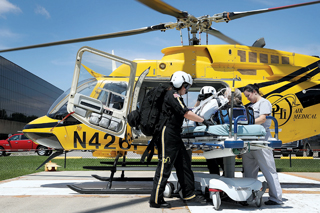
The devastation of hurricanes Harvey and Irma hit the Gulf Coast and Florida harder than expected, but in their wake has been an unrivaled display kindness, fortitude and generosity from the communities and from around the world.
As nearly anyone in the long-term and post-acute care fields would attest, such graciousness is part of the culture. Yet underlying all the activity are a new mindset and batch of regulations that providers must contend with.
“We’ve heard from our communities that through all the devastation and all the challenges, this storm has demonstrated the resolve that the men and women in long-term care have,” Texas Health Care Association President and CEO Kevin Warren told McKnight’s in early September. “We’ve talked to owners, staff, and leaders who are staying in their facilities, doing everything they can to help, working 12 on and 12 off, but all the while not knowing if they have a house to go home to.”
Indeed, with some 4,500 residents evacuated from more than 130 Texas nursing homes and assisted living facilities [as of Labor Day], there was a great deal of work to do.
Along with the aftermath of the disasters, the last few months of this year will bring a trio of compliance deadlines from the Centers for Medicare & Medicaid Services.
In addition to Phase II of the “Conditions of Participation” and release of a new survey and certification process, nursing homes must contend with the Nov. 15 deadline for the Emergency Preparedness Requirements for Medicare and Medicaid Participating Providers and Suppliers final rule.
“As you can imagine, it’s a lot for providers,” says LeadingAge’s Director of Health Regulations and Policy Janine Finck-Boyle, MBA/HCA, LNHA. “Overall, it’s a lot of work, especially with the timing. And rural facilities are feeling particularly taxed due to the fact that all providers must do one community-wide coordinated drill each year.”
The annual drill must include entities such as local firefighters, hospitals, elementary schools, police department and the like (see box on page 46 for details of the core elements of the rule), Finck-Boyle explains.
Ultimately, though, top of mind should be having an emergency plan in place that encompasses all of the strategies to be deployed with any potential hazard.
“If they’ve done an all-hazards vulnerability analysis, which many have done as part of their emergency prep, that’s where they should be focusing their efforts so they can develop their plans and update them annually and then test that plan with the community,” Finck-Boyle says.
Big policy
Compared to previous regulations addressing emergency preparedness, the new rule represents a significant shift in policy and practice, says Stan Szpytek, president of Fire and Life Safety Inc., a consulting firm that provides life safety, risk management and emergency preparedness programs for providers.
“In the past, you had to do fire drills, you had to do emergency plans, and you had to evacuate the building. But subsequent to the rule, it’s a complete culture change for the industry.”
Szpytek notes that under the new rules, providers must assess their resident population and determine if anyone has special needs such as a tracheotomy, oxygen or mobility assistance. Facilities must have the capability to deal with each special need and it must be documented in the plan.
“If the surveyors come in and they see that you’ve got a ten-page plan, and you can’t make a case to the surveyor that you’ve assessed the risks and perils, and you’ve analyzed your capacity and capabilities, and if a plan wasn’t developed in accordance with that process, you’ll probably be deficient,” he says.
In the 12 months since CMS issued the rule, suppliers and vendors have stepped up to help providers prep with tools, checklists and resources, as well as merchandise and technology solutions. HealthCap Risk Management and Insurance, for example, added an emergency preparedness rule to its annual sweep of educational seminars around the country.
‘Crazy’ training
Among other things, the company recommends that facilities take the time to do at least one active-shooter drill.
“I’ve been in this business for 35 years and if someone told me 10 years ago that I would be recommending an active-shooter training, I would have thought they were crazy,” says Angie Szumlinski, director of risk management at HealthCap. She notes that some of the Federal Emergency Management Agency’s videos (available on the FEMA website) were helpful complements to the CMS resources. Especially useful, she says, was the “Run, Hide, Fight” video.
Seemingly mundane things can be easy to forget but also are important. HD Supply, for example, has created a resource for its customers with an emergency preparedness mini-catalog that includes everything from palettes of water to signage and generators.
“The items in the catalog will help facilities sustain their operations and recover well from emergencies,” says Daniel Wicker, safety and compliance product consultant for HD Supply Facilities Maintenance. Wicker also has traveled to a number of state provider organization meetings to speak about the rule.
Integrating plans
Erin Wheeler, administrator at Knollwood Military Retirement Community in Washington, D.C., says she has been in prep mode for months. Among the biggest challenges she’s faced is coordinating with other facilities and finding time to conduct joint drills.
“But we are further along in the process because we’re a military community and we’ve already conducted an all-hazards assessment and approach to our emergency preparedness efforts,” she notes.
Wheeler is referring to the federally recommended Incident Command System (ICS), which is a standardized, on-scene emergency management concept designed to allow responders to adopt an integrated organizational structure.
The system is the basis of a response management system for many federal agencies and was adapted to work in the nursing home setting in 2009.
Providers that have already adopted the Nursing Home ICS, or NHICS, are ahead of the game, says Szpytek, who is a 26-year veteran of a Chicago-area fire department and has been training providers on the system for a number of years.
“It’s an all-hazards framework of command and control that is integrated to most emergency systems,” he says. “The [NHICS] itself and all FEMA forms and documents are standardized but tweaked to work within the discipline in which you are working.”
At Knollwood, Wheeler is creating a video of its training sessions so that all staff members can access and view them at any time.
“We are working systematically to train staff on every shift, and we are going to do it on a routine basis,” she says, noting that both LeadingAge and the District of Columbia Health Care Association have created excellent resources for providers.
Natural disasters like Harvey and Irma further emphasize the importance of preparation and the necessity of the emergency preparedness rule, Warren said.
“Everyone should be as prepared and coordinated as possible, and having the ability to collaborate and communicate effectively is imperative,” she says.
CMS has a website that contains resources at: https://www.cms.gov/Medicare/Provider-Enrollment-and-Certification/SurveyCertEmergPrep/Templates-Checklists.html.
The 4 Core Elements
Providers and suppliers are required to meet four core elements (with specific requirements adjusted based on the individual characteristics of each provider and supplier):
1. Emergency plan — Develop an emergency plan based on a risk assessment and using an “all-hazards” approach, which will provide an integrated system that focuses on capacities and capabilities.
2. Policies and procedures — Develop and implement policies and procedures based on the emergency plan and risk assessment that are reviewed and updated at least annually. For long-term care facilities, hospitals and critical access hospitals, this must address the provision of subsistence needs, such as food, water and medical supplies, for staff and residents, whether they evacuate or shelter in place.
3. Communication plan — Develop and maintain a communication plan that complies with federal, state and local laws. Patient care must be coordinated within the facility, across healthcare providers, and with state and local public health departments and emergency management systems.
4. A training and testing program — Develop and maintain training and testing programs, including initial training in policies and procedures. Facility staff will have to demonstrate knowledge of emergency procedures and provide training at least annually. Facilities must conduct drills and exercises to test the emergency plan.
From the October 01, 2017 Issue of McKnight's Long-Term Care News





